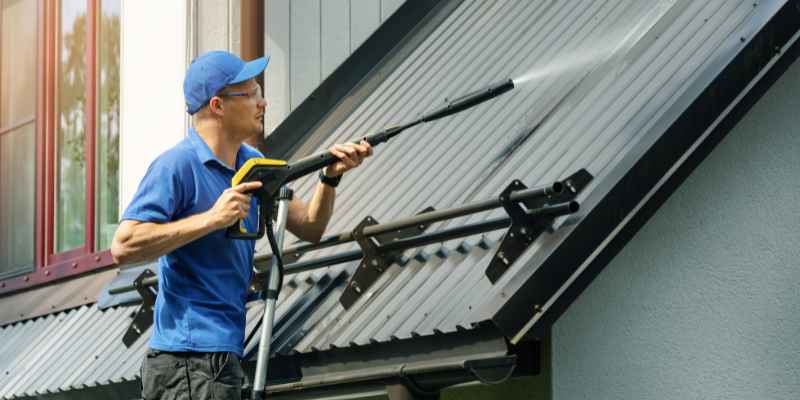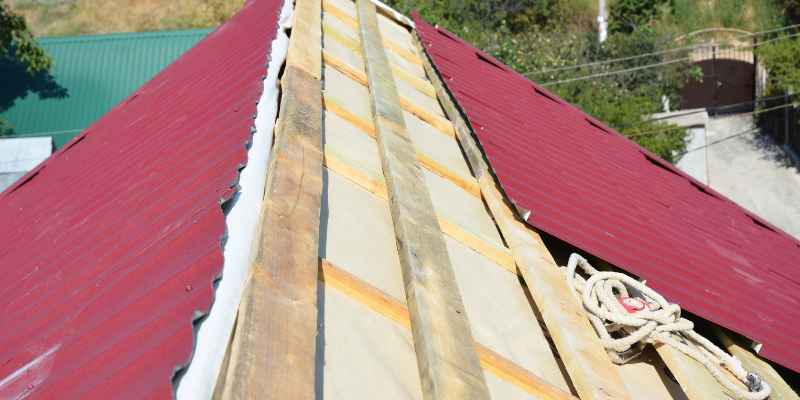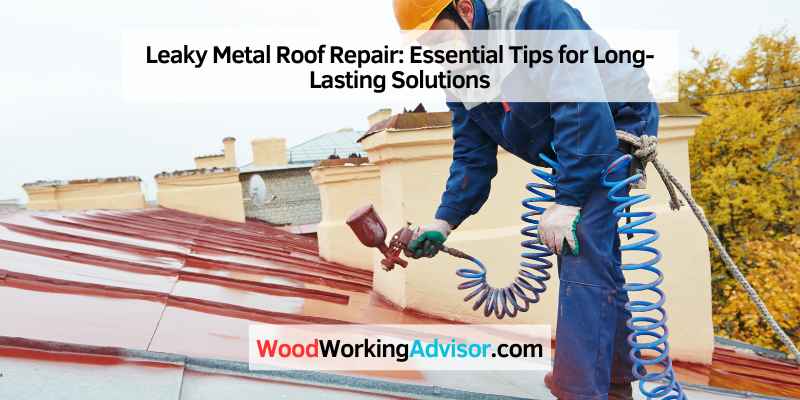To repair a leaky metal roof, identify the source of the leak and patch it promptly. Delaying repairs can lead to extensive damage.
A leak in your metal roof can be a cause for concern, as even a small leak can result in significant damage over time. It is essential to address the issue as soon as possible to prevent further water infiltration and potential structural issues.
In this guide, we will discuss some effective methods for repairing a leaky metal roof and provide tips for preventing future leaks. Whether you choose to handle the repair yourself or hire a professional, taking action promptly can help protect your property and save you from costly repairs in the long run.
Causes Of Metal Roof Leaks
Metal roof leaks can be caused by factors like improper installation, aging sealants, or corrosion. Identifying the root cause and addressing it promptly is crucial for effective leaky metal roof repair. Regular maintenance and inspections can help prevent leaks and prolong the lifespan of your metal roof.
Understanding the common causes of metal roof leaks is crucial for proper maintenance and timely repair. Identifying the root of the issue can help prevent extensive damage and preserve the integrity of your roof. Let’s explore some major reasons why metal roofs develop leaks.
Improper Installation
Roof leaks may occur due to incorrect installation practices, such as improper sealing or inadequate fastening. Even minor mistakes during installation can lead to water ingress, causing leaks over time.
Age And Deterioration
Aging metal roofs are susceptible to corrosion and deterioration, which can weaken the material and create vulnerabilities. Over time, exposure to the elements can compromise the roof’s integrity and lead to leaks.
Punctures And Holes
Punctures or holes in a metal roof can result from falling debris, impact damage, or wear and tear. These openings provide entry points for water, causing leaks that worsen if left unaddressed.

Identifying Metal Roof Leaks
Water Stains And Discoloration
- Look for water stains on ceilings or walls.
- Discolored areas can indicate leaks.
Visible Damage
- Check for missing or damaged metal panels.
- Rust or corrosion is a sign of leaks.
Inspecting From Inside
| Step | Description |
|---|---|
| 1 | Check attic for water damage. |
| 2 | Look for light penetration through the roof. |
Diy Metal Roof Repair
Metal roofs are known for their durability and long lifespan. However, over time, leaks and damages may occur, causing the need for repair. Fortunately, with a few basic tools and materials, you can fix small holes and punctures or even replace damaged panels on your metal roof. In this guide, we’ll walk you through the process of DIY metal roof repair, step by step.
Gather Necessary Tools And Materials
Before starting your DIY metal roof repair, it’s essential to gather all the necessary tools and materials. Having everything at hand will save you time and frustration during the repair process. Here’s a list of items you’ll need:
- Roofing screws
- Butyl tape or sealant
- Roofing nails
- Metal snips or tin cutters
- Safety glasses and gloves
- Ladder or scaffolding
- Measuring tape
- Screwdriver or drill
Clean And Prep The Damaged Area
Before you proceed with any repairs, it’s crucial to clean and prep the damaged area on your metal roof. This ensures better adhesion and a longer-lasting fix. Follow these steps:
- Remove any debris or loose dirt using a broom or brush.
- Use a solution of mild detergent and water to clean the damaged area.
- Rinse with water and allow it to dry completely.
- If there’s rust on the damaged surface, gently sand it to remove any loose particles.
Sealing Small Holes And Punctures
If you have small holes or punctures in your metal roof, you can seal them effectively using the following method:
- Clean the damaged area as mentioned in the previous step.
- Cut a piece of butyl tape or apply a sealant over the hole, ensuring complete coverage.
- Press the tape or sealant firmly onto the surface to create a watertight seal.
- If necessary, you can use roofing screws or nails to secure the tape or sealant in place.
Replacing Damaged Panels
In more severe cases where the damage cannot be repaired with a simple seal, you may need to replace the damaged metal panels. Follow these steps to ensure a proper replacement:
- Remove any nails or screws securing the damaged panel.
- Measure the dimensions of the damaged panel accurately.
- Cut a new panel to size using metal snips or tin cutters.
- Place the new panel into position, ensuring it aligns correctly with the surrounding panels.
- Secure the new panel with roofing screws or nails.
Hiring A Professional Roofing Contractor
If you’re dealing with a leaky metal roof, it’s crucial to hire a professional roofing contractor to address the issue effectively. From obtaining multiple quotes to examining the contractor’s licensing and insurance, there are various considerations to ensure that you choose the right professional for the job. Here are some key factors to keep in mind:
Research And Obtain Multiple Quotes
Research different roofing contractors to obtain multiple quotes. This allows you to compare services and pricing to find the best value for leaky metal roof repair.
Check For Proper Licensing And Insurance
Ensure the contractor possesses the necessary licensing and insurance for roofing work. This safeguards you from liability and ensures the contractor meets legal requirements.
Ask For References And Past Work
Request references and examples of past roofing work. This provides insight into the contractor’s track record and allows you to gauge their level of expertise and quality of work.
Get A Written Contract
Obtain a written contract that outlines all the details of the roof repair project, including costs, timelines, and materials. This ensures clarity and accountability throughout the repair process.
Preventing Future Metal Roof Leaks
Preventing future metal roof leaks is essential to maintaining the integrity of your building and avoiding costly repairs. By implementing regular maintenance, clearing debris, addressing issues promptly, and applying protective coatings, you can effectively safeguard your metal roof from potential leaks.
Regular Maintenance And Inspections
Regular maintenance and inspections are crucial for identifying and addressing potential issues before they escalate into major leaks. Through scheduled assessments, you can detect and repair any damage, such as corrosion or loose panels, to maintain the structural integrity of the metal roof.
Clearing Debris And Maintaining Gutters
Regularly removing debris, leaves, and other obstructions from the roof and gutters is vital for preventing water backup and subsequent leaks. Ensuring that gutters and downspouts are clear and functioning properly is essential for effective water drainage and the prevention of standing water, which can lead to leaks.
Addressing Any Issues Promptly
Addressing any issues promptly is paramount to preventing future metal roof leaks. Whether it’s loose fasteners, damaged sealant, or minor corrosion, addressing these issues as soon as they are identified can help prevent them from progressing into larger, more damaging problems.
Consider Applying Protective Coatings
Applying protective coatings to the metal roof can provide an additional layer of defense against the elements and potential leaks. These coatings can help seal seams, protect against corrosion, and enhance overall water resistance, prolonging the life of the roof and reducing the risk of leaks.
Common Mistakes To Avoid
When it comes to leaky metal roof repair, it’s important to avoid common mistakes. Ensuring proper sealing of seams, addressing rust spots promptly, and using high-quality sealants are key to effective repair. Additionally, overlooking small leaks can lead to bigger issues, so timely maintenance is crucial.
Using Incorrect Repair Materials
One of the most common mistakes you should avoid when undertaking a leaky metal roof repair is using incorrect repair materials. Using the wrong materials can lead to ineffective repairs and potentially worsen the problem. It’s crucial to identify the specific type of metal roof you have and use the appropriate repair materials designed for that particular material.
Using the wrong repair materials can cause further damage to your roof and compromise its structural integrity. Be sure to consult with a professional or refer to the manufacturer’s recommendations to ensure you’re using the correct materials for your specific metal roof type.
Neglecting Underlying Issues
Another mistake to avoid when repairing a leaky metal roof is neglecting the underlying issues. While fixing visible leaks is important, it’s equally vital to address any underlying problems that may be contributing to the leaks.
Common underlying issues with metal roofs can include rust, corrosion, loose or missing fasteners, and damaged flashing. Failure to address these underlying issues can result in recurring leaks, even after performing repairs.
Take the time to thoroughly inspect your roof for any signs of damage or deterioration beyond the obvious leaks. Addressing these underlying issues will ensure a more effective and long-lasting repair.
Incomplete Repairs
Completing the repair process fully is crucial to successfully fixing a leaky metal roof. One common mistake to avoid is performing incomplete repairs, which can lead to persistent leaks and further damage.
When repairing your metal roof, make sure to identify and fix all potential areas of concern. This includes addressing not only the visible leaks but also sealing any gaps, cracks, or damaged areas that could potentially lead to future leaks. Taking a comprehensive approach to repairs will prevent the need for repeated fixes.
Not Following Safety Precautions
Safety should always be a top priority when repairing a leaky metal roof. Failing to follow proper safety precautions can put you at risk of accidents and injuries. It’s important to wear appropriate safety gear such as gloves, goggles, and a helmet when working on your roof.
Additionally, use proper ladder and scaffolding techniques to ensure stability and avoid falls. Always work with a partner or have someone nearby who can assist if needed.
By adhering to these safety guidelines, you can protect yourself and minimize the risk of accidents while repairing your leaky metal roof.
When To Consider Roof Replacement
If your metal roof is experiencingextensive damage and leaks, it may be time to opt for a replacement.
Extensive Damage And Leaks
- Visible signs of water intrusion or rust.
- Leaking in multiple areas despite repairs.
- Structural issues compromising roof integrity.
If you notice significant roof deterioration and continual problems, replacing the roof is a wise choice.
Significant Roof Deterioration
- Curled, cracked, or missing metal panels.
- Widespread damage due to age or weather conditions.
- Roof fatigue causing consistent issues.
Multiple recurring issues can signal the need for a new roof to avoid ongoing repair costs and inconvenience.
Multiple Recurring Issues
- Frequent leaks despite repair efforts.
- Continuous need for patches or fixes.
- Deterioration spreading to various sections.
Considering acost-benefit analysis is crucial before deciding on roof replacement versus repair.
Cost-benefit Analysis
- Evaluate total repair expenses versus replacement cost.
- Consider long-term benefits of a new, durable roof.
- Weigh upfront investment against future savings.

Frequently Asked Questions On Leaky Metal Roof Repair
How Can I Identify A Leak In My Metal Roof?
To identify a leak in your metal roof, look for water stains, mold, or peeling paint on the ceiling. Additionally, check for rust spots, loose seams, or damaged flashing on the exterior. Regular inspections and maintenance can help catch leaks early.
What Are The Common Causes Of Metal Roof Leaks?
Metal roof leaks can be caused by improper installation, damaged flashing, rust or corrosion, loose screws or fasteners, or weather-related factors such as hail or wind damage. Regular maintenance and addressing these issues promptly can prevent leaks.
Can I Repair A Metal Roof Leak Myself?
Minor metal roof leaks can often be repaired by homeowners who are comfortable working at heights. It’s important to use the right materials and follow proper safety protocols. For extensive leaks or if unsure, it’s best to consult professional roof repair services.
When Should I Consider Replacing My Metal Roof Instead Of Repairing It?
If your metal roof has extensive rust or corrosion, widespread damage, or is reaching the end of its lifespan, it may be more cost-effective to replace it rather than continually repairing leaks. Consulting with a roofing professional can help determine the best course of action.
Conclusion
Taking proper steps to repair a leaky metal roof is essential in maintaining the integrity of your home. By identifying the source of the leak, using high-quality sealants, and following proper repair techniques, you can save yourself from the hassle of a costly replacement.
Investing in regular maintenance and addressing leaks promptly will ultimately prolong the lifespan of your metal roof and protect your home from potential damage. Don’t let a leaky roof rain on your parade – take action now and safeguard your home for years to come.


